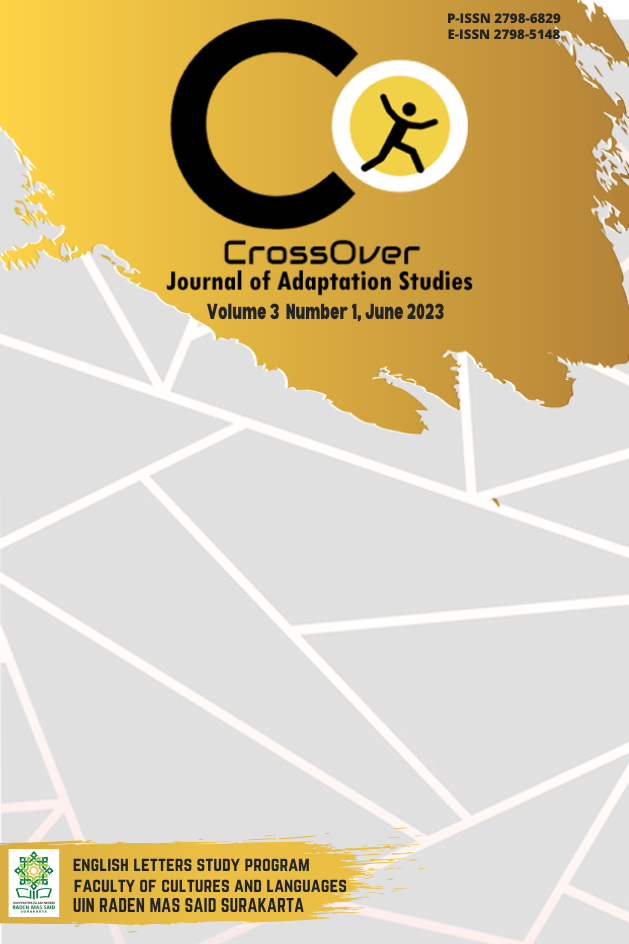PYGMALIONIZATION: DO ACTION FIGURES, NENDOROIDS, AND PLUSHIES OF FILMS AND GAMES TELL A STORY?
DOI:
https://doi.org/10.22515/crossover.v3i1.7063Keywords:
adaptation, ergodic literature, merchandise, nano-narratives, paratextualityAbstract
Studies on merchandise or merch as paratexts that serve as nano-narratives in adaptation context are under investigated. We argue that treating merchandise of hyped films and games as in the mentioned fashion might disclose a novel perspective in perceiving them as a narrative text. Employing the theories of paratextuality by Genette, ergodic literature by Aarseth, ludic adaptation by Purnomo et al., franchising storytelling by Parody and nano-narratives by Petten on a corpus of merch from forty animated films and games, we proposed a neologism that we dubbed pygmalionization. This perspective refers to adapting animated films and games into toy-based merch e.g. action figures, nendoroids, and plushies and treating them as paratexts with the purposes of serving nano narratives and of extending the narrative experiences methectically and metathectically to the general audiences and fans through transtylization. This study is expected to provide insights for adapted merchandise makers and scholars in regard to treating the merchandise as a paratext with nano-narrative functions.
Downloads
References
Aarseth, E. J. (1997). Cybertext: Perspectives on ergodic literature. JHU Press.
Affuso, E. (2018). Mediated merchandise, merchandisable media: An Introduction. Film Criticism, 42(2). https://doi.org/10.3998/fc.13761232.0042.201
Caillois, R. (2001). Man, play, and games. University of Illinois press.
Elliott, K. (2014). Tie-Intertextuality, or, Intertextuality as Incorporation in the Tie-in Merchandise to Disney’s Alice in Wonderland (2010). Adaptation, 7(2), 191-211. http://dx.doi.org/10.1093/adaptation/apu007
Gallagher, M. (2006). Action figures: Men, action films, and contemporary adventure narratives. Springer.
Genette, G. (1997). Paratexts: Thresholds of interpretation (No. 20). Cambridge University Press.
Huizinga, J. (2014). Homo ludens: A study of the play-element in culture. Routledge.
Hutcheon, L. (2012). A theory of adaptation. Routledge.
Ingham, A. G., & Loy Jr, J. W. (1974). The structure of ludic action. International
Review of Sport Sociology, 9(1), 23-62.
Keidl, P. D. (2018). Between textuality and materiality: Fandom and the mediation of action figures. Film Criticism, 42(2). https://doi.org/10.3998/fc.13761232.0042.207
Nachbar, J., Nachbar, J. G., & Lausé, K. (Eds.). (1992). Popular culture: An introductory text. Popular Press.
Nikolajeva, M. (2010). Interpretative codes and implied readers of children’s picturebooks. In New directions in picturebook research (pp. 45-58). Routledge.
Parody, C. (2011). Adaptation essay prize winner: Franchising/adaptation. Adaptation, 4(2), 210-218. http://dx.doi.org/10.1093/adaptation/apr008
Petten, A. J. (2010). The narrative structuring and interactive narrative logic oftelevised professional wrestling. New Review of Film and Television Studies, 8(4), 436-447. https://doi.org/10.1080/17400309.2010.514666
Purnomo, L. A., Untari, L., Purnama, L. S., Asiyah, N., Umam, R. K., Sartika, Y., ... & Inderasari, E. (2021). Ludic Adaptation: Can We Babyfy, Chibify, Bambify, or Cherubify a Literary Text for Younger Audiences?. GEMA Online Journal of Language Studies, 21(1). http://dx.doi.org/10.17576/gema-2021-2101-06
Santo, A. (2017). Fans and merchandise. In The Routledge companion to mediafandom (pp. 329-336). Routledge.
Spradley, J. P. (2016). Participant observation. Waveland Press.
Wasko, J. (2020). Understanding Disney: The manufacture of fantasy. John Wiley & Sons.
Williams, R. (2019). Funko Hannibal in Florence: Fan Tourism, Participatory Culture, and Paratextual Play. JOMEC Journal, (14), 71-90. http://dx.doi.org/10.18573/jomec.179.
Downloads
Published
How to Cite
Issue
Section
Citation Check
License
Copyright (c) 2023 Mohammad Romdhoni Prakoso, Rizki Adi Yanuasari, SF Lukfianka Sanjaya Purnama, Lusiana Prihastiwi

This work is licensed under a Creative Commons Attribution-ShareAlike 4.0 International License.
Authors retain copyright and grant the journal right of first publication with the work simultaneously licensed under a Creative Commons Attribution 4.0 International License that allows others to share the work with an acknowledgment of the work's authorship and initial publication in this journal.

















